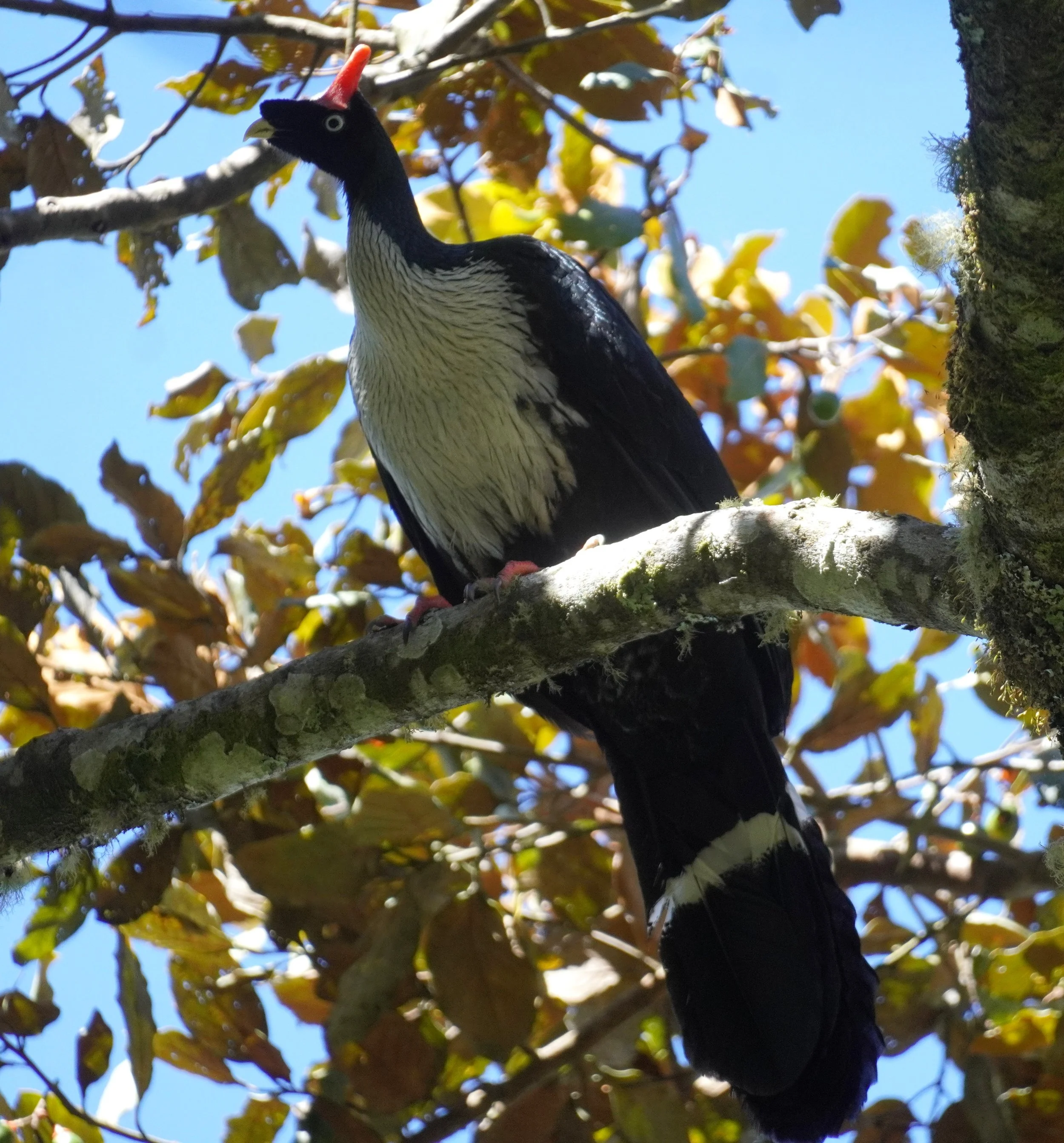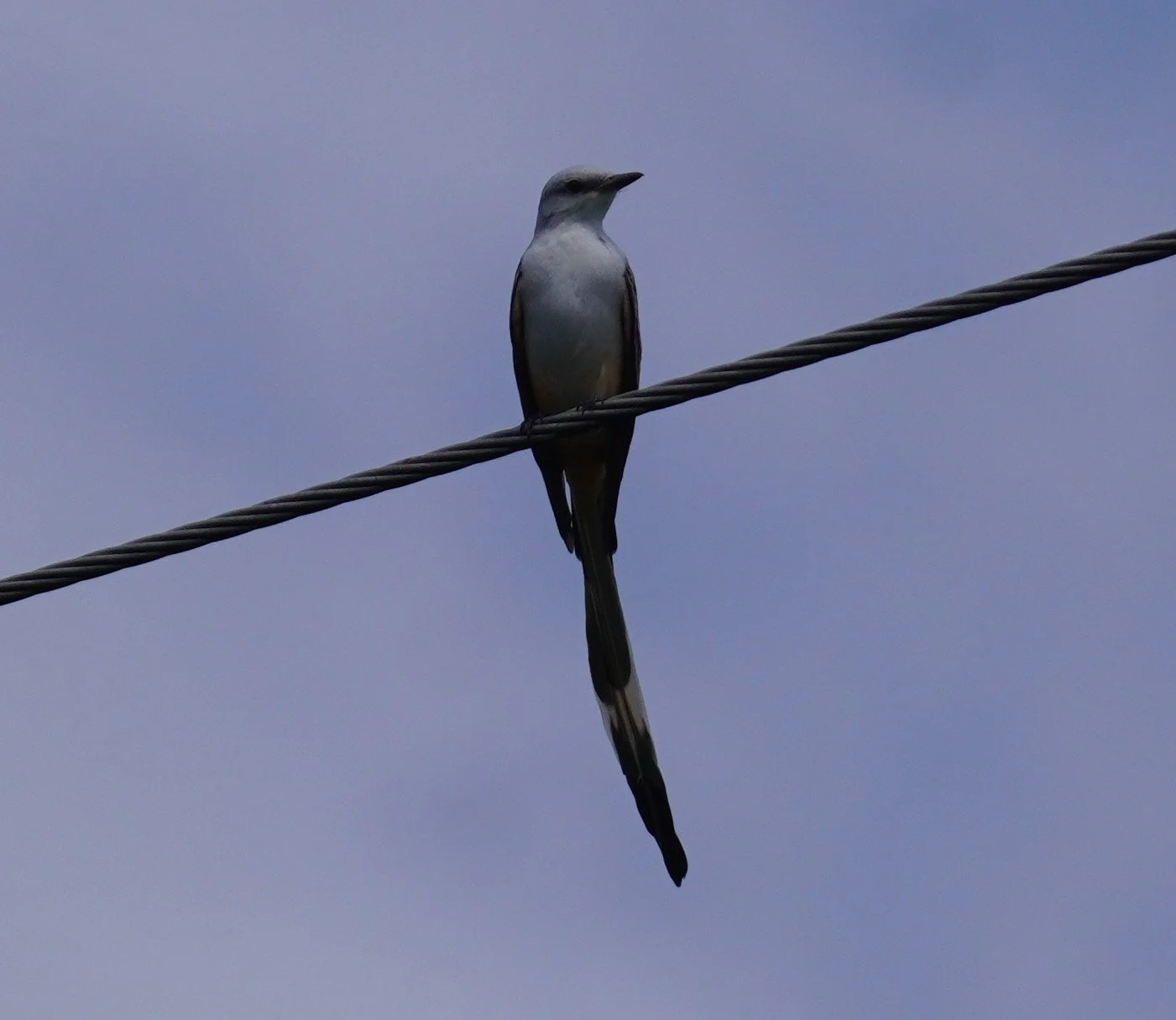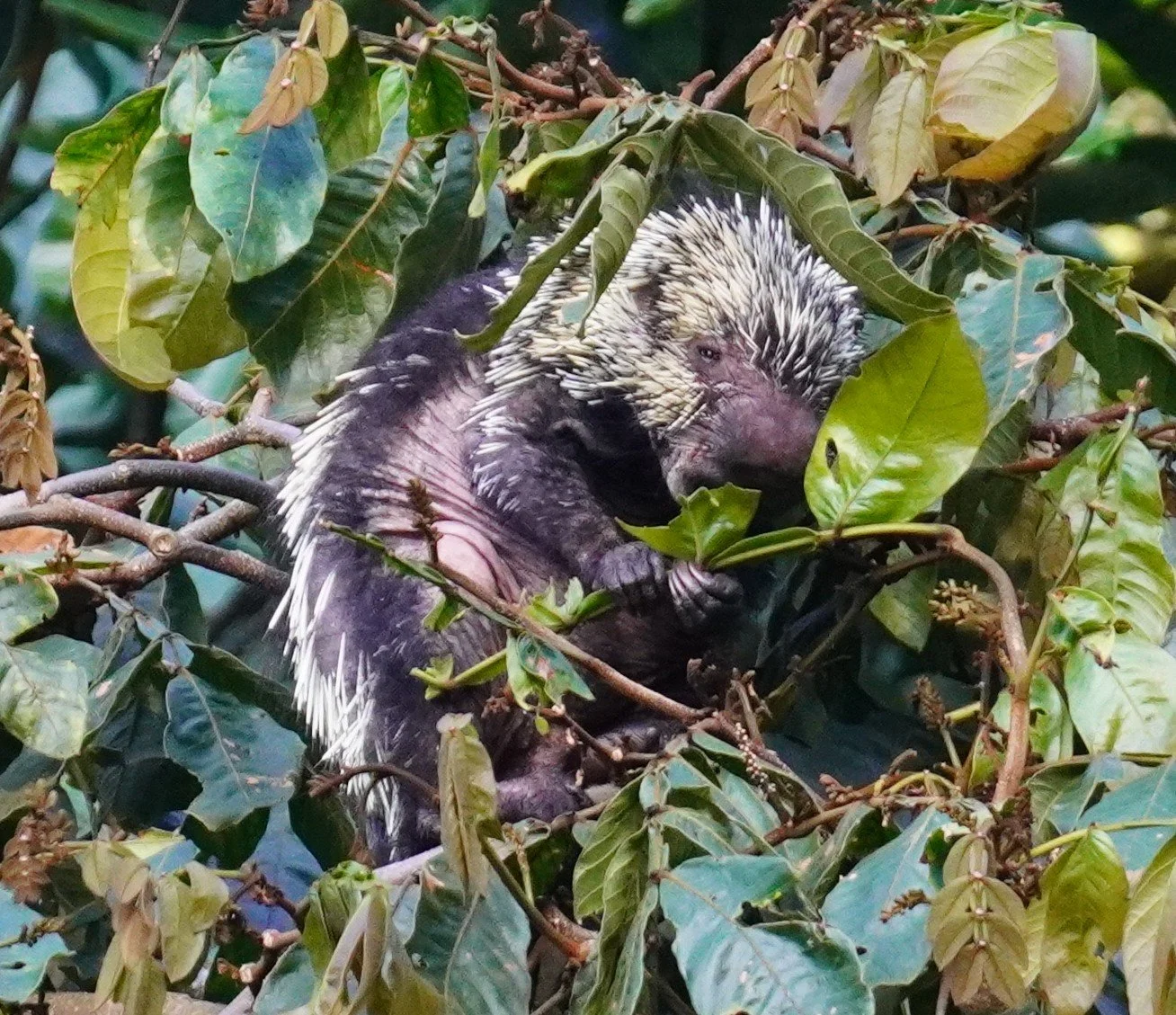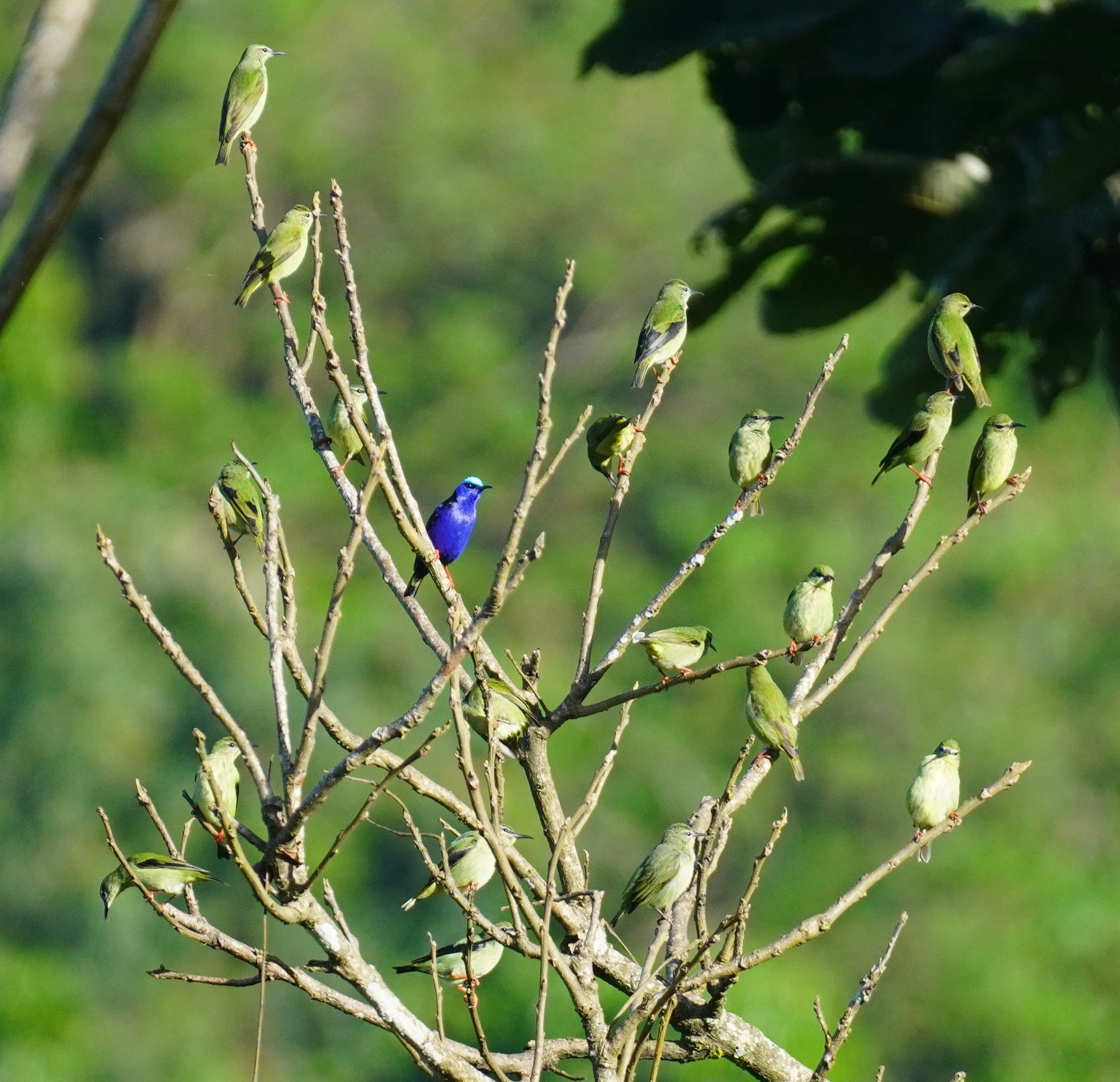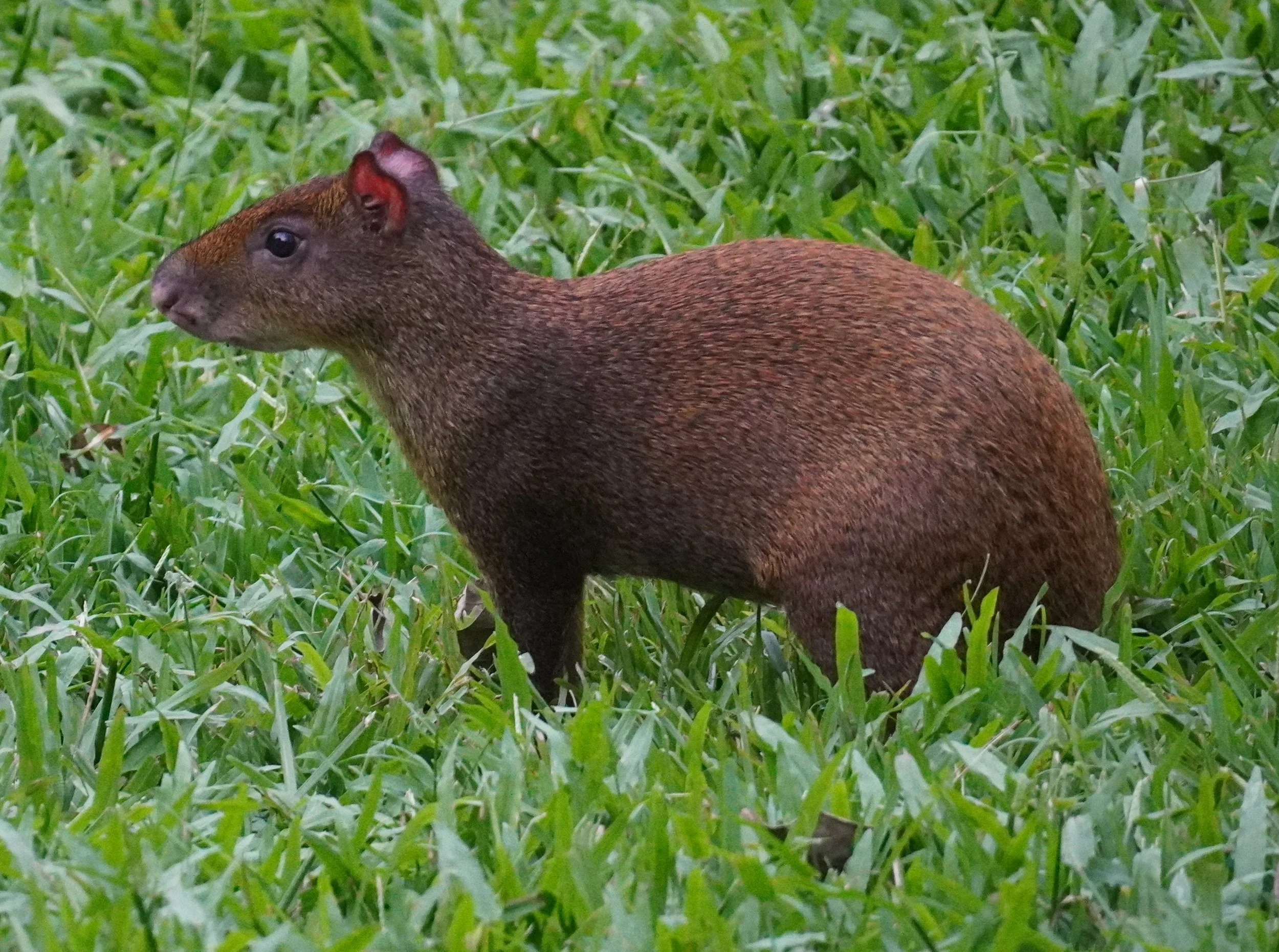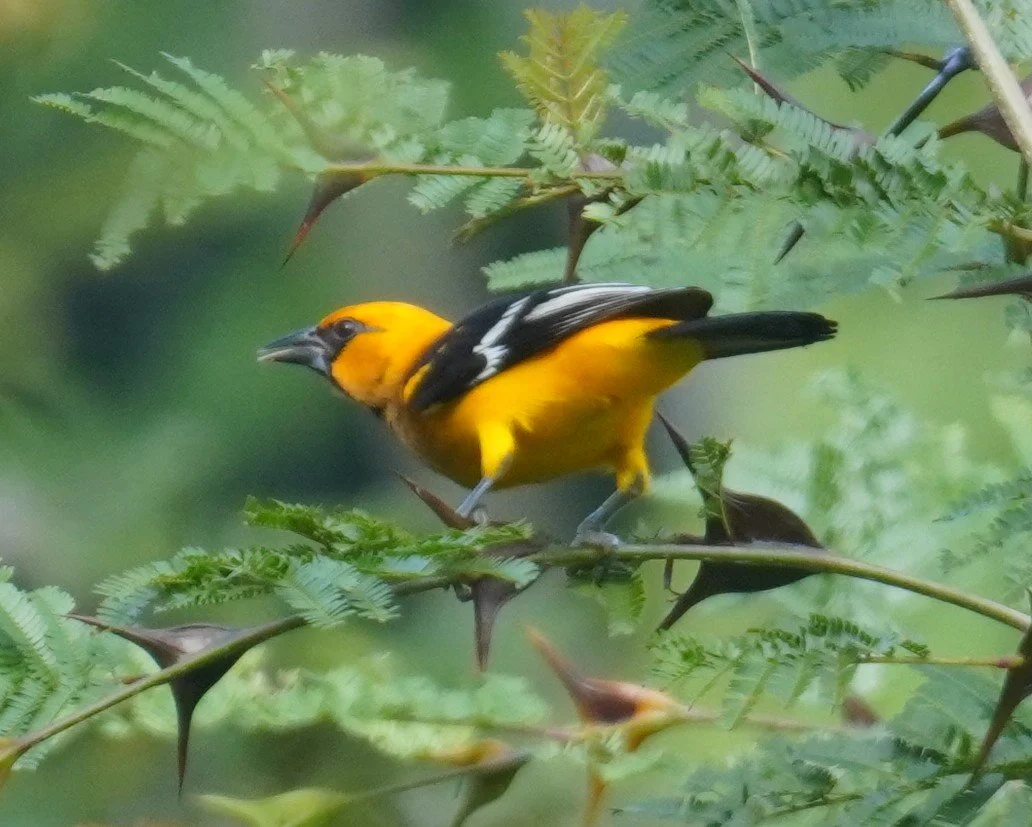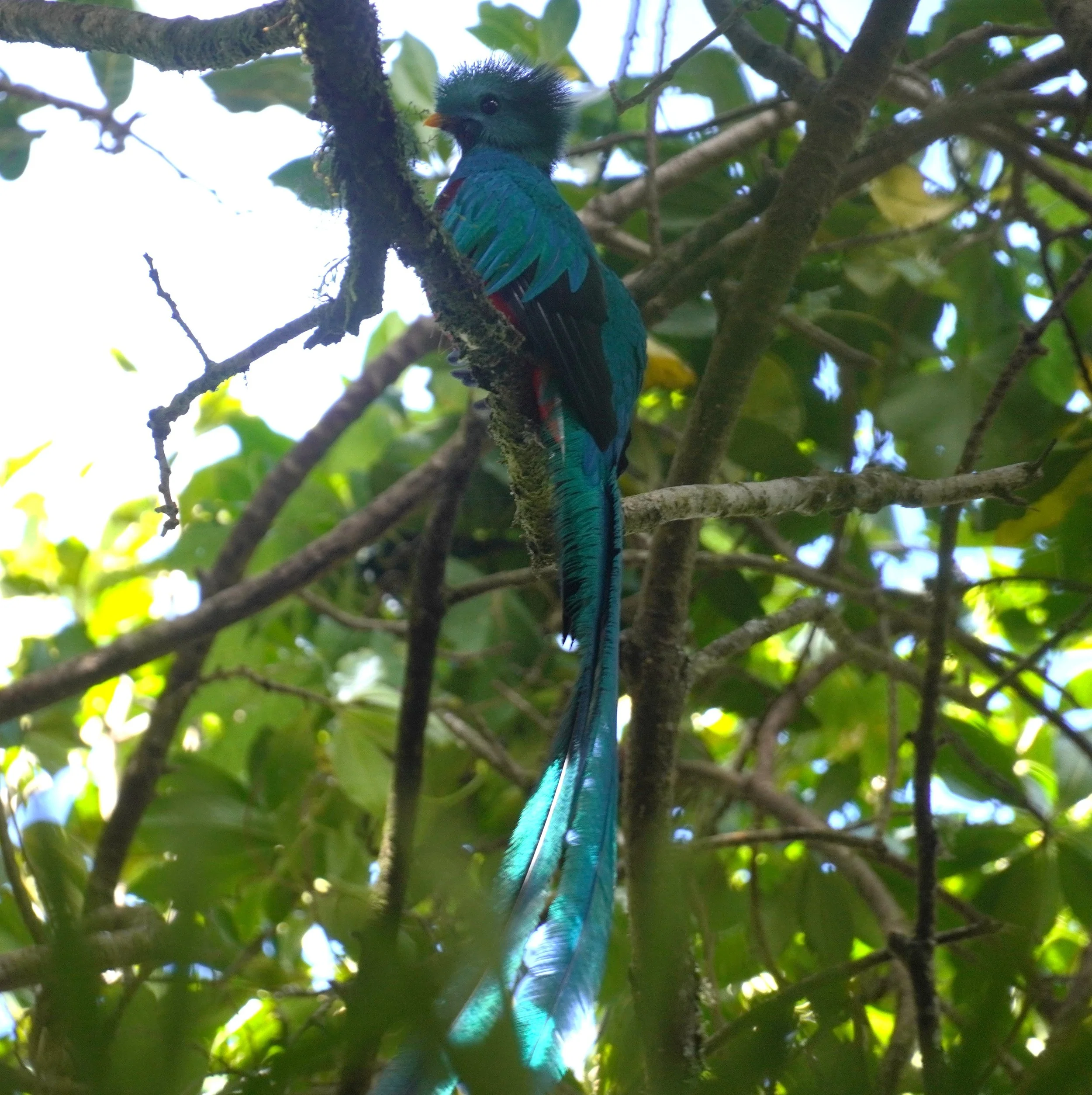Trip Leaders: Pedro Najarro – In-country Guide, Brian Rapoza – TAS Field Trip Coordinator
Participants: Adrin Andalib (Virginia), Andrea Diamond (Florida), Sherrie Downing (Maine), Susan Guilford (Maine), David Martin (Colorado), Ann Martinez (Florida), Vilma Valdes (Florida), William Uttenweiller (Florida), Laurie Yntema (Maine) and Lisa Yntema (Virgin Islands)
Trip report and photos by Brian Rapoza
Overview: Ten birders participated in this 11-day tour of southern Guatemala’s highland areas, which began and ended in Guatemala City. The first two days of the tour were spent visiting birding locations near Antigua, Guatemala’s colonial capital. The remainder of the tour was spent birding on or near the dormant Atitlan volcano and around scenic Lake Atitlan. By the conclusion of the tour, the group produced a bird list numbering over 220 species, including Guatemala’s national bird, the Resplendent Quetzal, regional endemics such as Horned Guan, Slender Sheartail and Azure-rumped Tanager, plus 19 different hummingbirds, 24 wood-warblers and many others.
Daily Summaries (names in bold indicate our first encounter with that species)
Day 1: Wednesday, November 5
Andrea, Susan, Ann, Vilma, William and I arrived in Guatemala City this afternoon on the same flight from Miami. Upon making our way through immigration and exiting the airport terminal, we were expecting to be greeted by our guide Pablo, but all we could find once outside was a massive crowd of locals waiting for their loved ones to exit. As it turned out, Pablo was waiting for us at a different door, but eventually, the crowd dissipated and Pablo was able to locate us. Sherrie, David and Laurie’s flight arrived about an hour after ours, so once they exited the terminal, we were all escorted to our bus, our luggage was loaded onboard, and we began our drive to Antigua. Once settled in at the Porta Hotel Antigua, our base for the tour’s first two nights, the entire group assembled for dinner, including Lisa, who had arrived in Antigua the day before and Adrin, who had arrived early this morning. The sun was already setting when most of the group arrived at the hotel, so the only birds identified there were a few Great-tailed Grackles around the hotel’s pool and a large, swirling flock of Vaux’s Swifts overhead. We also had our first views of the volcanic peaks that loom over this area, including the active Fuego volcano.
Day 2: Thursday, November 6
Bushy-crested Jay
While enjoying breakfast, we were distracted by several birds in the hotel’s gardens, including White-winged Dove, Azure-crowned Hummingbird, Golden-fronted Woodpecker, Clay-colored Thrush and Tennessee Warbler. Our first Rock Pigeons were seen just outside the hotel as we drove back towards Guatemala City to our first birding destination of the tour, an ecological park called Cerro Alux that protects a beautiful pine-oak forest. A welcoming committee of Bushy-crested and Steller’s Jays greeted us upon arrival. Many other birds were tallied during our exploration of the park: Inca Dove, White-eared and Rivoli’s Hummingbirds, Turkey Vulture, Blue-throated Motmot, Acorn Woodpecker, Guatemalan Flicker, Pacific Parakeet (heard only), Spot-crowned Woodcreeper, Hammond’s and Yellowish Flycatchers, Hutton’s and Blue-headed Vireos, Band-backed Wren, Brown-backed Solitaire, Rufous-collared Robin, Black-headed Siskin and an impressive mix of resident and migrant wood-warblers, including Black-and-white, Crescent-chested, MacGillivray’s, Townsend’s, Hermit, Black-throated Green, Rufous-capped, Golden-browed and Wilson’s Warblers and Slate-throated Redstart.
We returned to Antigua for lunch and some sightseeing; some in the group saw Social Flycatcher, Tropical Kingbird, House Sparrow, Lesser Goldfinch and Rufous-collared Sparrow while we were in town. Later in the afternoon, we paid a visit to Finca El Pilar, a private reserve with hummingbird feeders attracting seven different species during our visit, including four new ones: Green-throated Mountain-gem, Rufous and Violet Saberwings and Berylline Hummingbird. Other new trip birds encountered during this stop included Muscovy Duck (feral), White-tipped Dove, Sharp-shinned Hawk, Great Horned Owl (heard only), American Kestrel, Dusky-capped (heard only) and Boat-billed Flycatchers, Swainson’s Thrush, Summer Tanager and Black-headed Saltator.
Day 3: Friday, November 7
Common Squirrel-Cuckoo
After breakfast and checkout, we bid goodbye to Antigua and drove south to the Finca San Cayetano coffee plantation, located near Fuego volcano, which was billowing dark smoke when we arrived. In over three hours of birding on the plantation’s trails, we tallied 54 species, including the only Bar-winged Oriole encountered on the tour. Many other new birds were seen during our visit, including Red-billed Pigeon, Common Squirrel-Cuckoo, White-collared Swift, Ruby-throated Hummingbird, Black Vulture, Gray Hawk, Ferruginous Pygmy-Owl, Lesson’s Motmot, Lineated Woodpecker, Masked Tityra, Brown-crested Flycatcher, Great Kiskadee, Western Kingbird, Philadelphia and Western Warbling Vireos, Black-capped and Barn Swallows, Southern House, Rufous-backed and Cabani’s Wrens, White-throated Thrush, Scrub Euphonia, Spot-breasted and Baltimore Orioles, Bronzed Cowbird, Melodious Blackbird, Magnolia and Northern Yellow Warblers, Western and Yellow-winged Tanagers and Red-legged Honeycreeper. Heard-only birds included Long-tailed Manakin, Yellow-olive Flatbill, Yellow-throated Vireo and Gray-breasted Wood-Wren.
Scissor-tailed Flycatcher
The route to our next destination, Los Andes Reserve, located on the southern slopes of the Atitlan volcano, took us briefly down into the Pacific lowlands, then back up into the mountains. We stopped for lunch at a roadside restaurant, where we met Evé, a local guide who joined our tour for the next several days. We also found three new birds while at the restaurant: Groove-billed Ani, Yellow-throated Euphonia and Altamira Oriole. Other new birds seen during the drive to Los Andes were Western Cattle Egret, Roadside and Red-tailed Hawks, Black Phoebe, Scissor-tailed Flycatcher, White-throated Magpie-Jay and Northern Rough-winged Swallow.
After arriving at Finca Los Andes, our home for the next two nights, we birded a bit around the gardens, adding our last four new species for the day: Blue-tailed and Cinnamon Hummingbirds, Golden-olive Woodpecker and Chestnut-capped Warbler. A thunderstorm chased us inside just as it was getting dark; incredibly, that was the only rain we experienced during the entire tour!
Day 4: Saturday, November 8
Today’s agenda included our first long, difficult hike of the tour, on the Quetzal Trail, which provides access to cloud forest habitat on the upper slopes of the Atitlan volcano. This hike required an early start, a bagged breakfast and a bumpy ride up to the trailhead on the back of a truck normally used to transport cattle. During our ride up the mountain, we passed dozens upon dozens of coffee plantation workers who were hiking up to where they would be harvesting coffee beans that morning. At one point, when the truck couldn’t negotiate a particularly slippery stretch of the road, many of the workers, including a woman carrying an infant, were asked to climb up into the truck with us, in the hope that the added weight would provide the traction needed for the truck to make it to the trailhead. Low and behold, the strategy worked! We arrived at the trailhead just as the sun was rising and were treated to spectacular views of the mountains to the east, including the Fuego volcano, now considerably more distant.
Mexican Hairy Dwarf Porcupine
Our main target for this hike was Resplendent Quetzal. This bird is a cavity nester and artificial nest boxes have been installed in appropriate habitat along the trail to encourage breeding. While several of these nest boxes were pointed out to us during the hike, we never saw any quetzals. Most of the birds we encountered were seen early in the hike, with only a few species found around the highest elevations of the trail. Several of the birds were heard only for most of the group, including Crested Guan, Black Hawk-Eagle, Tody Motmot, Northern Emerald Toucanet, Laughing Falcon, Barred Parakeet, Greenish Elaenia, Spot-breasted Wren, Orange-billed Nightingale-thrush, Blue-crowned Chlorophonia, and Yellow-faced Grassquit. New birds that most of us managed to see included Emerald-chinned Hummingbird, Collared Trogon, Yellow-bellied Sapsucker, Hairy Woodpecker, Bat Falcon, Scaly-throated Foliage-gleaner, Guatemalan Tyrannulet, Least Flycatcher, Long-billed Gnatwren, Common Chlorospingus, Gray-crowned Ground-Sparrow, Orchard Oriole, Golden-crowned Warbler, and White-winged and Azure-rumped Tanagers, the latter a regional endemic. We also found our first mammal of the tour: a Mexican Hairy Dwarf Porcupine!
Turquoise-browed Motmot
The truck that brought us up to the trailhead was unable to drive up to where we ended our hike, so we rode back to Finca Los Andes on a trailer being pulled by a tractor. After lunch, some of the group birded around the gardens (a Cinnamon-bellied Saltator was new) while others took a much-needed siesta, hoping to quickly recover from the long hike. The group reassembled prior to sunset to search for owls and other nocturnal species along the lower section of the road leading up to the Quetzal Trail. Among the birds seen before nightfall were Turquoise-browed Motmot, Collared Aracari, Crested Caracara, Northern Tropical Pewee and Blue-gray Tanager. A Ruddy Foliage-gleaner was heard only, but had scope views of a Laughing Falcon, so we took that bird off the “heard only” list. We were unable to find any owls, but we did see two nightjars: Lesser Nighthawk and Common Pauraque. Our most unexpected sighting, though, were the three Great Curassow that we flushed from the road!
Day 5: Sunday, November 9
Red-legged Honeycreepers
During our final morning at Finca Los Andes, we took a couple of short walks, one before breakfast and another after we ate. New birds seen before breakfast included Long-billed Starthroat, Common Tody-Flycatcher, Northern Beardless Tyrannulet, Eastern Bluebird, Louisiana Waterthrush, Rose-breasted Grosbeak, Painted Bunting and Morrelet’s Seedeater. We obtained distant views of a Crested Guan, taking another bird off the “heard only” list. Our sighting of a small leafless bush completely covered in Red-legged Honeycreepers was also notable. Without a doubt, the highlight of our after-breakfast walk was when Evé found an immature Ornate Hawk-Eagle! It got even better when an adult Ornate Hawk-Eagle was spotted circling over the tree where the immature bird was perched. An honorable mention should be given to the Green-breasted Mango that was seen in this same area.
Though our next destination, Los Tarrales Reserve, is also located on the southern slopes of the Atitlan volcano, to get there we had to drive back down to the lowlands, then take another road back up into the highlands. Our first Short-tailed Hawk of the tour was seen just after we exited Los Andes Reserve. We made a lunch stop at a restaurant right next door to the restaurant where we ate two days earlier. Our first Rose-throated Becard of the tour was among the birds spotted outside this restaurant. We made a quick stop along a river near the town of San Juan Bautista, adding several new birds, including Spotted Sandpiper, Black-crowned Night Heron, Tricolored and Green Herons, Snowy and Great Egrets and Amazon and Green Kingfishers. We also found several White-throated Magpie-Jays there. A Eurasian Collared-Dove was seen in the town.
Central American Agouti
We arrived at Los Tarrales mid-afternoon, which provided us with an opportunity to bird around the lodge for a couple of hours before sunset. Three new parrots were found: Yellow-naped and White-fronted Amazons and Orange-fronted Parakeet. We also obtained our best views yet of Pacific Parakeet. Another new trip bird was White-bellied Chachalaca, which was abundant at this reserve but not seen anywhere else on the tour. We also saw two new trip mammals: Central American Agouti and White-tailed Deer. A banana feeding station at the lodge attracted a nice mix of birds, including Golden-fronted Woodpecker, Clay-colored Thrush, Yellow-throated Euphonia, Spot-breasted and Baltimore Orioles, Melodious Blackbird, Yellow-winged Tanager and Black-headed Saltator, while Cinnamon Hummingbird, Lesson’s Motmot and Collared Aracari were seen in the surrounding gardens.
Day 6: Monday, November 10
Altamira Oriole
Today, we had an opportunity to explore several trails within the reserve, all of them close to our lodge. Our early morning walk began at dawn and produced a list of over 70 different species! While most of these birds were also seen on previous days, we added a few new ones, including Orange-chinned Parakeet, Barred Antshrike, Ivory-billed Woodcreeper, Rufous-breasted Spinetail, Rufous-browed Peppershrike, Rufous-browed Wren, Yellow-breasted Chat and Yellow-billed Cacique. Some of us were able to obtain brief views of a Long-tailed Manakin, which we only heard at Finca San Cayetano. We saw many more White-bellied Chachalacas than yesterday, found five different hummingbirds (Ruby-throated, Berylline, Blue-tailed and Cinnamon, plus Long-billed Starthroat) two motmots (Lesson’s and Turquoise-browed), three woodpeckers (Golden-fronted, Lineated and Golden-olive), four orioles (Orchard, Spot-breasted, Altamira and Baltimore) and both Black-headed and Cinnamon-bellied Saltators. We also added another mammal, Red-bellied Squirrel, to our list.
After breakfast, we tried a different trail and recorded over 50 species. We found six different hummingbirds, including two new ones (White-bellied Emerald and Blue-throated Goldentail), plus two new hawks (Broad-winged and Zone-tailed), a new warbler (Chestnut-sided) and a new bunting (Indigo). White-breasted Wood-wren was also new, though heard-only. After lunch and an early afternoon siesta, we visited another section of the refuge and recorded over 40 species, including four new ones: Gartered Violaceous Trogon, Yellow-bellied Flycatcher, Violet-green Swallow and Blue-black Grassquit. We also obtained nice views of Greenish Elaenia, which was a heard-only bird at Los Andes, and much better views of Rufous-browed Peppershrike than we had this morning. After sunset, we searched for both Spectacled and Mottled Owl but were unable to locate any.
Day 7: Tuesday, November 11
This morning, our last at Los Tarrales, began with a power outage, likely due to gusty winds that would have also made it difficult (not to mention, dangerous) for us to search for birds in the forest. Though power was restored in about an hour, a decision had already been made to pack up the bus earlier than originally scheduled and move on to our next destination, Lake Atitlan, where we hoped it would not be as windy.
Our first opportunity to view this magnificent lake, located in a massive volcanic caldera, came when we stopped for breakfast at a restaurant overlooking the eastern side of the lake. While waiting for breakfast to be served, we spotted our first two new trip birds of the day: Band-tailed Pigeon and American Coot. After breakfast, we visited an area of dry forest in the village of San Robles, where Evé lives. After a couple of hours of searching, our main target species for this location finally appeared for us: a Belted Flycatcher, which is another regional endemic. Among the 25 species tallied while searching for the Belted Flycatcher were three other new birds: Tufted Flycatcher, Greater Pewee and Nashville Warbler. New as a heard-only bird was Central American Pygmy-Owl, though it was only heard by one member of the group. Lesser Goldfinch was also new for most of the group.
After bidding farewell to Evé, we stopped for lunch at a restaurant in the town of San Lucas Toliman. While having lunch, we spotted a flock of Bushtits and a Tropical Mockingbird in the restaurant’s garden; both were new for the trip. Yet another new bird, a Gray Silky-flycatcher, was spotted on the drive to the town of Santiago Atitlan, located on the south side of the lake, and where Hotel Bambu, our lodging for the next two nights, was located. Our last four new birds for the day were seen on the grounds of the hotel: Common Gallinule, Yellow-bellied Elaenia, Black-vented Oriole and Northern Waterthrush.
Day 8: Wednesday, November 12
Fulvous Owl
Our second, and final long, difficult hike of the tour once again took us up the slopes of Atitlan volcano, this time on the volcano’s western side via the Mirador del Tepepul Trail. An early start and a bagged breakfast were once again required, and our main target bird was once again Resplendent Quetzal. The trail began near a paved road, so we were able to be transported to the trailhead on our bus. In addition to Pedro, we also had a local guide, Diego, who makes this climb on a regular basis and was very confident that we would find a quetzal. Diego’s young nephew joined us as well. Early in the climb, we went off trail for a short distance where Diego called in a Fulvous Owl that he reliably finds in this area. Two other new birds were seen on the way up: White-faced Quail-Dove and Wine-throated Hummingbird.
After another two or three hours of climbing, Diego declared that we were now in appropriate habitat for the quetzal. Not too long after, a quetzal was spotted, but it quickly flew off before most of us could even lift our binoculars. Higher up, we could hear a quetzal vocalizing somewhere off trail, but no one was able to spot it. Diego’s nephew scampered off trail in search of the bird and within seconds began signaling us to follow him. As we made our way toward him, the bird flew directly overhead, back toward the trail. We turned around and went back to the trail, looked up, and there it was, an adult male Resplendent Quetzal, perched directly above us.
Resplendent Quetzal
The bird had apparently flown to a preferred perch and didn’t seem to be bothered by our presence. Taking advantage of our good fortune, we snapped tons of photos. It seemed wrong to just walk away from such a beautiful bird, so we didn’t. Eventually, the quetzal was flushed a short distance from its perch; when we looked around to see what had made it move, we couldn’t believe our eyes. It was a Horned Guan! We knew that this near-mythical bird could be found on Atitlan volcano, but we weren’t really expecting to see one, since they typically are found only near the volcano’s peak. This guan was just as obliging as the quetzal, so once again, we snapped countless photos. Eventually, the guides informed us that we had stayed there much longer than planned, so we reluctantly began our descent. Two new birds were seen on the way down: Hooded Grosbeak and Flame-colored Tanager. Another new bird was heard only, a Mountain Trogon. We ended our eight-hour hike with “only” 31 species, but this was most certainly a case of quality over quantity.
After a late lunch back at the hotel, we were offered an opportunity to visit IMAP Sendero de Aves, a private garden where a new hummingbird for the trip, Slender Sheartail, could reliably be found. We were led to the area where the hummingbird was usually found and waited patiently until it made an appearance. The bird, a male, was only visible for a second or two before darting out of view. It repeated this behavior multiple times, but eventually almost everyone obtained a glimpse of the bird. We saw a few other birds during the 90 minutes we were there, but only two others, Cooper’s Hawk, which just about everyone saw, and Rusty Sparrow, which only a few of us saw, were new.
Day 9: Thursday, November 13
Before breafast, we drove back to the Mirador del Tepepul area and birded along the roadside, hoping to find something new. In about 45 minutes of birding, we recorded 11 species, including Band-tailed Pigeon, Green-throated Mountain-gem, Brown-backed Solitaire, Black-headed Siskin and Slate-throated Redstart. Returning to the hotel, we found 27 species there, including a Merlin, which was new, and a female Slender Sheartail, which was new for anyone who missed it yesterday.
After breakfast and checkout, we boarded a chartered boat that transported us to the town of San Pedro La Laguna, located on the west side of Lake Atitlan. A squadron of “tuk-tuks” was hired to transport the group to a women’s textile cooperative, where we attended a demonstration of how indigenous hand-woven fabrics are made. The group was then given some time for shopping in town, after which we had lunch at a restaurant overlooking the lake. As always, we kept our eyes open for birds during lunch, producing a list of 14 species, including a heard only Common Yellowthroat, which was new for everyone, and a Rufous-collared Sparrow, which was new for most of the group.
After lunch, our boat transported us back across the lake, but this time to the town of Panajachel, located on the north side of the lake, where we would spend the night. Our hotel, the Porta Hotel Del Lago, was a short walk from the boat dock. Our bus and luggage were waiting for us when we arrived. After checking in, we jumped on the bus and headed to Atitlan Reserve, located a short drive from the hotel, for about an hour of late afternoon birding. We produced a bird list of 22 species, including a Rusty Sparrow, which was missed by some the first time it was seen.
Day 10: Friday, November 14
For our last full day of the tour, we drove west from Panajachel to Corazon del Bosque Ecological Park, a reserve of high elevation pine-oak forest that is home to the Pink-headed Warbler, a regional endemic found only in Guatemala and southern Mexico. We spent nearly four hours searching for this bird but couldn’t find any. We managed to find three trip birds, though: Olive Warbler, White-naped Brushfinch and Painted Redstart. We also saw a Mountain Trogon, which was previously heard-only, along with other previously seen regional specialties like Guatemalan Tyrannulet, Bushy-crested Jay, Rufous-collared Robin and Crescent-chested Warbler.
During the drive back to Guatemala City, we made one more stop, for lunch at a restaurant surrounded by pine-oak forest where Pink-headed Warbler, as well as Amethyst-throated Mountain-gem, another regional endemic, are often seen. We spent nearly two hours searching for these two species but found neither. As consolation, we did find three other birds that were new for the trip: Mexican Violetear, Brown Creeper and Blue-and-white Mockingbird!
After checking in to our hotel in Guatemala City, we met as a full group for one last time, for a farewell dinner.
Day 11: Saturday, November 15
Sherrie, Laurie and Lisa had very early flights this morning and were already on their way home by the time the rest of us made our way downstairs for breakfast. After breakfast, Adrin, Bill and I walked to Plaza España, a tree-lined median with a bike path that was only a block from our hotel, just to see what birds we could find there. Andrea and Ann later joined us. We found a nice variety of birds there, but one bird we found was a species we hadn’t seen before: Grace’s Warbler, our last new bird on the tour! Other birds seen there included White-winged Dove, American Kestrel, Least and Social Flycatchers, Blue-headed Vireo, Bushtit, Baltimore Oriole, Black-and-white, Tennessee and Northern Yellow Warblers, Rose-breasted Grosbeak, and Summer, Blue-gray and Yellow-winged Tanagers.
A Final Word: All of the birds we saw or heard during the tour, all of the eBird checklists we submitted and all of the photos added to those checklists can be viewed in this eBird trip report. David Martin submitted his photos to iNaturalist and Google Photos; these photos can be viewed by clicking on the links below:
Birds Butterflies and Insects Mammals Reptiles
Amphibians Plants Fungi and Lichens Scenes
I would like to thank Pablo Najarro, our in-country guide, who worked tirelessly to ensure that everything went according to plan, and everyone had an amazing experience during our time in his beautiful country. I must also thank Manuel, our bus driver, for attending to all our needs and keeping us safe during our journey. Thanks to Evé, Diego and our other local guides, as well as the hard-working hotel staff at all our lodges, for your contributions to the success of our tour. Finally, I need to thank Holbrook Travel, especially Travel Consultant Jill Hays and Air Specialist Fran Whitlock, for organizing and handling all the logistics for our tour.
Horned Guan: banner photo by Brian Rapoza

